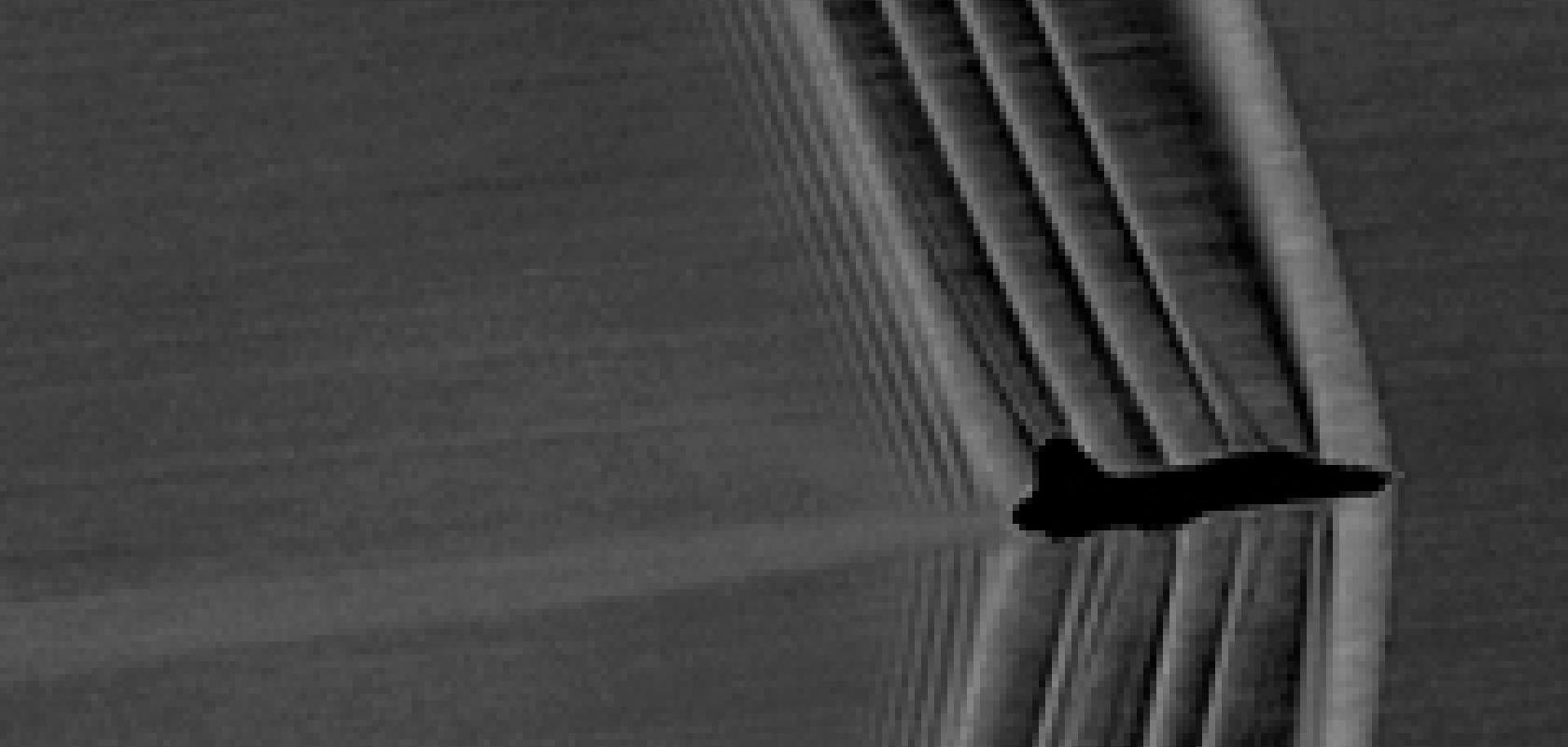High-speed imaging of the shockwaves produced when an aircraft goes supersonic is aiding NASA scientists in a project to develop a quiet supersonic aircraft.
NASA was awarded a contract for the preliminary design of a ‘low boom’ flight demonstration aircraft in the first in a series of X-planes in NASA's New Aviation Horizons initiative. The work could pave the way to commercial supersonic flight over land.
The Commercial Supersonic Technology Project aims to build a piloted test aircraft that can fly at supersonic speeds and create a soft thump – what NASA is calling a supersonic heartbeat – rather than the disruptive boom currently associated with supersonic flight.
To study the shockwaves caused by a jet breaking the sound barrier, NASA refined schlieren photography – a technique that images the flow of air around objects – to give enhanced image quality by effectively using the sun as a background.
The 'Background Oriented Schlieren using Celestial Objects' (BOSCO) technology captured images of shockwaves produced by a US Air Force Test Pilot School's T-38 aircraft travelling at supersonic speeds.
The technique used a hydrogen-alpha solar filter installed in one of three modified high-speed cameras positioned strategically on the ground. The filter meant visually fine details of the sun could be seen. The supersonic aircraft and its shockwaves can then be seen clearly in front of the solar background.
Observing air density changes makes the details clearer, explained BOSCO principal investigator Mike Hill. ‘The hydrogen alpha filter basically looks at light coming off of certain hydrogen atoms on the sun’s surface,’ he said. ‘By looking at one specific wavelength of light it brings texture out on the image of the sun. That texture is what we use to process the raw images into schlieren images.
‘As the light rays come through the flow around the airplane, the different air density caused by the flow bends the light, which allows us to see the texture of the sun’s surface move on the digital image. We can calculate how far each speckle on the sun moved, and that gives us the schlieren image.’

An Air Force Test Pilot School T-38 passes in front of the sun at supersonic speed, creating shockwaves that are captured using schlieren photography to visualise supersonic flow. Credits: NASA Photo / Ken Ulbrich
This concept is similar to seeing heat waves that are emanating from a hot surface in the summer. The blur of the objects in the distance is visible because the hot air over the surface is a different density than the air around it. When light travels through that density change, it bends, causing objects in the background to appear blurry to the eye.
The BOSCO technique is one of two new NASA developments in the field of schlieren. The second involves using cameras on one airplane to photograph another. Both techniques are capable of producing images of greatly improved quality, and each has unique features.
‘One advantage for BOSCO is that we’re flying one airplane,’ Hill explained. ‘We can have our cameras on the ground, and we can use consumer-grade telescopes and non-flight rated equipment. We don’t need to put any imaging equipment on an airplane, so there are obvious savings in operational costs.’
This method can be applied to imaging wing vortex locations and relative strengths important for NASA Armstrong’s research into improved efficiency for subsonic aircraft.
Commercial Supersonic Technology subproject manager Brett Pauer says the first flights for BOSCO met high expectations. Pauer was involved in NASA’s photographic research of shockwaves through AirBOS, CaKEBOS, and Ground-to-Air Schlieren Photography System (GASPS).
‘I am very happy with these flights,’ Pauer stated. ‘Our Air Force pilots were spot on, our ground operators performed very well, and we captured some spectacular images. These have been our most successful ground-based schlieren flights yet.’
The data collected from the flights will help engineers determine the most sufficient method of designing and executing further tests in NASA’s research of shockwaves created by supersonic flight. The overall goal of the schlieren imaging research is to develop a system to image the shock waves propagating from the bottom of the aircraft to the ground. This necessitates imaging a side view of the aircraft in near level flight.
Visualising these complex flow patterns of shockwaves produced by a supersonic vehicle will allow NASA researchers to validate design tools used to develop the proposed Quiet Supersonic Technology (QueSST) research aircraft. QueSST will be the first ever aircraft to demonstrate supersonic flight with the soft sonic ‘thump’, and could unlock the future to commercial supersonic flight over land.
‘Developing, building and flight testing a quiet supersonic X-plane is the next logical step in our path to enabling the industry's decision to open supersonic travel for the flying public,’ said Jaiwon Shin, associate administrator for NASA’s Aeronautics Research Mission.
NASA selected a team led by Lockheed Martin Aeronautics to complete a preliminary design for QueSST. Lockheed Martin will receive about $20 million over 17 months for QueSST preliminary design work.
Further information:


